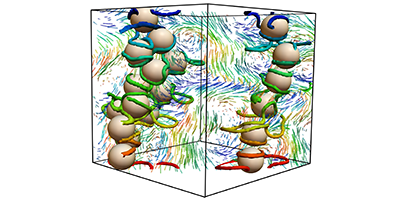Electrically Dancing Colloids
Dispersing colloid particles in liquid crystals can disrupt the well-ordered arrangement of the liquid crystal molecules. This can lead to the formation of complex defect structures, which introduce additional interactions between the colloids that could be used to steer the system into new states. Now, Giuseppe D’Adamo from the International School for Advanced Studies (SISSA), Italy, and colleagues have shown theoretically that an electric field can control liquid crystal colloid composites so that they form a wide variety of structured patterns.
The authors considered a group of spherical colloids embedded in a liquid crystal with chiral ordering. With no applied field, a helical pattern forms around the colloid as the chirally ordered liquid crystal molecules try to align perpendicularly to the colloid’s surface. The application of an electric field can control the alignment of the liquid crystal molecules, changing how they order around the colloid.
Taking electric fields with different amplitudes and waveforms, D’Adamo et al. found that the system could be driven through different metastable states. The result was the formation of structures, including single and double rings, loops, and other more complex networks around the colloids. The calculations showed that the repetitive on-off switching of the electric field changed the structure of such defects. These changes, in turn, produced a force that could be used to move the colloids in a specific direction, push apart colloid dimers, or reposition randomly placed colloids so that they form columnar or planar array structures. The authors suggest that their scheme might provide rapidly reconfigurable materials for optical applications.
–Katherine Wright
This research is published in Physical Review Letters.





